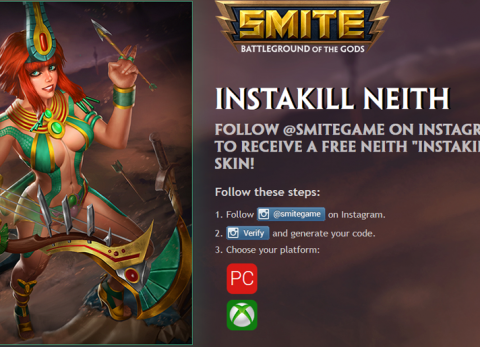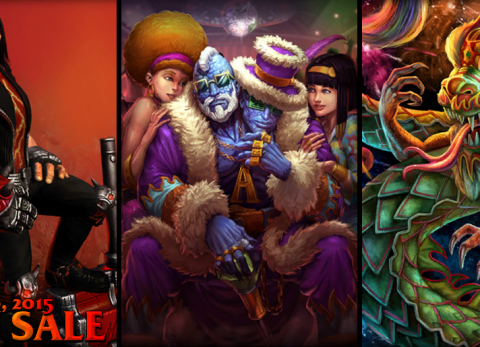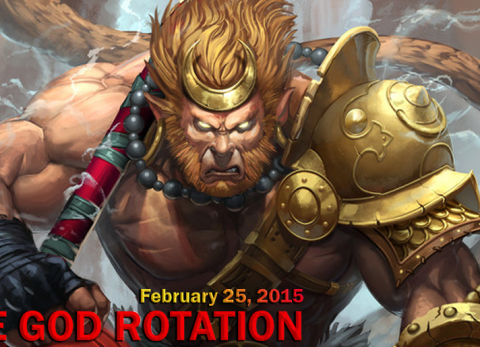So you want to play SMITE, but you have no idea where to begin. You saw it on the front page of IGN and Twitch, you skimmed a headline about it on Kotaku, and you saw an episode about it on Game Theorists. Now you want to know more; you want to play it. You want to find out what all the fuss is about, but you have no clue where to start. MOBAs are tough. They’re hard to learn and even harder to master; the maps are dispiriting, the game modes are intimidating, the number of gods is daunting, and the lists of items and builds are just plain disheartening.
But there is hope. Everyone starts somewhere, and Hi-Rez does an excellent job making the game intuitive, accessible, and fun, regardless of time commitment or experience level. From auto-level and auto-buy to developer-sponsored guides and how-to videos, SMITE is easily the most approachable MOBA on the market. Here is a compilation of everything you need to know to start playing SMITE: Battleground of the Gods.
What is SMITE?
SMITE: Battleground of the Gods is a multiplayer online battle arena (MOBA) developed and published by Hi-Rez Studios. In it, teams of mythological gods square off and fight in various arenas. By leveling skills, buying items, farming minions, and coordinating attacks, players work together to defeat enemies and secure objectives. Like other games, SMITE features a wide selection of playable characters, and each character makes use of five unique active and passive abilities. Likewise, each character fills a specific role: Middle Lane, Carry, Support, Jungle, and Solo Lane. To win games, gods must play well at their positions and work cohesively with others.

Despite its similarities to other MOBAs, SMITE is unique. Most MOBA games feature an overhead view, click-based movements, and RTS-style hotkeys (namely Q,W,E, and R for abilities). SMITE uses an over-the-shoulder third-person camera, WASD controls, and a numbered hot-key system. This control scheme transfers amazingly to an Xbox One controller and is extremely intuitive across platforms. As a result, no matter what machine you are playing SMITE on, the game feels less like a MOBA and more like a shooter or an Action RPG. Players see everything their gods see (for better or worse) and control every movement.
SMITE is also extremely user friendly–especially for newbies. By default, all abilities and items are auto-purchased, allowing players to focus less on builds and strategies and more on playing and having fun. Auto-level and auto-purchase, of course can be turned off in settings; most players level and build items manually. The game also features several tutorials that can be found within the client (and on YouTube). These tutorials explain everything a new player would ever want to know about the game, including the topics covered in this introduction article.
GAME MODES
SMITE makes use of five game modes: Conquest, Arena, Joust, Assault, and Siege. For the sake of brevity, this introductory guide will only cover Conquest, Arena, and Siege.
Conquest
Conquest is a traditional MOBA map: three lanes protected by Towers, a Jungle filled with temporary beneficial items and monsters, and a base protected by three inhibitors (or Phoenixes). But SMITE changes things slightly. Since the game makes use of an over-the-shoulder camera, the traditional ‘top lane/bottom lane’ MOBA jargon is irrelevant. Instead, the game features a long lane and a short lane. The short lane is called, colloquially, the ‘solo’ lane, since only one god is necessary to defend it. Likewise, the long lane is called the ‘duo’ lane.
Gods spawn in the Fountain, a small area at the edge of each base. While standing in the Fountain, gods are able to regenerate Health and buy items. Players can teleport to the Fountain at any time during a match by pressing the recall button. Teleporting gods are not immune to damage though, and enemy gods can disrupt a god’s teleportation by simply attacking them. Due to this, it is best to teleport away from battle, preferably under a friendly Tower.

SMITE’s Conquest Jungle is slightly smaller than that of most other games. As a result, Junglers can move quickly between Camps and lanes, and gods in lanes can efficiently make use of Jungle Buffs. Among the Camps and Buffs available, each half of the map contains a movement speed camp, an attack speed camp, a mana camp, a damage camp, and various experience Camps. Aside from these basic Camps, there are also two challenge Camps–the Gold Fury and the Fire Giant. These Camps require high leveled gods or teams of gods to defeat them. The Gold Fury yields a large sum of gold, and the Fire Giant, the most powerful monster on the map, gives gold,experience, and a unique player buff.
To win Conquest, a team must defeat the enemy’s Titan–a large boss that lives in the enemy’s base. Each Titan is guarded by three Phoenixes that, when defeated, weaken the Titan and give a substantial power boost to the offensive team’s minions. Phoenixes regenerate after three minutes though, so teams should try to kill the Titan shortly after defeating them.
Siege
Siege is, more or less, a two-lane version of Conquest. Each side of the map contains four Towers, two Phoenixes, and a Titan. The map contains a small Jungle that carries Attack Speed, Attack Damage, and Mana Buffs. Like Conquest, teams must work together to kill minions, topple Towers, defeat Phoenixes, and destroy the enemy Titan, however; unlike Conquest, teams must work together to secure Siege Juggernauts – powerful minions that walk down the lanes, destroy everything in their path.. Each time a minion dies, an enemy god falls, or a team secures a Jungle Buff, a team earns points. When they collect 100 points, they summon a Siege Juggernaut. Alternatively, either team can kill the Wild Juggernaut in the center of the map (which re-spawns like a Jungle Buff) to secure a Juggernaut. Each team can have a maximum of two Siege Juggernauts active at any one time.

From here, whichever team kills the other’s Titan first wins, much the same as Conquest. But be careful, there’s a lot higher Jungle-to-lane ratio in this game mode, so watch out for stray enemies or team rotations!
Arena
Arena is SMITE’s most popular game mode. Unlike Conquest or Siege, there are no Towers or enemy objectives. Instead, players face off against each other and push minions into the enemy’s portal—a metaphysical hole at opposing ends of the map. Each team starts with 500 tickets. To win, teams must kill enemies and enemy minions and escort friendly minions into the enemy’s portal. Every time a god dies, five tickets are deducted; every time a minion is killed by a god or enters your portal, a ticket is deducted; and every time a siege Tower (a large minion Tower) enters your portal, fifteen tickets are deducted. The winner is the last team standing.
Starter Gods
There are sixty-three playable gods at the time of this writing. That said, finding an easy starter god can be daunting. Here are my three favorite beginner gods.
Ra
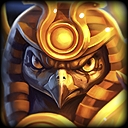
Ra is a strong, well-balanced mid-laner. A ranged Mage with healing abilities and crowd control, Ra pushes Towers extremely well. His passive, ‘Speed of Light’, allows him to gain movement speed every time he uses an ability. ‘Celestial Beam’, Ra’s first ability, fires a beam of light along the ground in front of Ra. Since it clears waves of minions extremely well, it is best to max this ability first. Ra’s second ability, Blinding Light, is an aura that charges around Ra. After two seconds, the ability detonates, slowing enemies and dealing damage. Ra’s third ability, ‘Solar Blessing’, creates a ring that functions both offensively and defensively; It damages enemies and heals allies. Ra’s Ultimate attack, ‘Searing Pain’, shoots a beam of extreme heat in front of Ra, dealing massive damage to all enemies in its path.
Thor
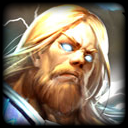
Thor is a powerful Assassin with high damage and high mobility. Thor’s passive ability, ‘Warrior’s Madness’, grants Thor Physical Power for every enemy god within thirty units of him. His first ability, ‘Mjolnir’s Attunement’, is a great mobility tool. Thor throws his hammer, dealing damage to all enemies in its path. As the hammer returns, it does double damage to all enemy gods it hits. Thor can also teleport to his hammer’s location mid-throw, allowing Thor to jump quickly into and out of battles. When Thor activates his second ability, ‘Tectonic Rift’, he smashes the ground, uprooting the ground in front of him. The rift stuns enemies and impedes enemy movement. Thor’s third ability, ‘Berserker Rage’, causes Thor to spin his hammer in a circle, damaging enemies every .4 seconds. Thor’s Ultimate, ‘Anvil of Dawn’, is one of the most useful assassination moves in the game. Thor flies up into the air and, at the point of your choosing, crashes down on an enemy, dealing damage and Stunning them. When paired with ‘Berserker Rage’ and ‘Mjolnir’s Attunement’, Thor’s Ultimate ends in at least one kill every time he uses it.
Ymir

Ymir is one of the most solid Guardians in the game. He is extremely tanky, and he can Crowd Control like no one else–a perfect support in the duo lane. His passive ability is ‘Frostbite’. Every time Ymir hits an enemy with an ability, he ‘frostbites’ them, meaning his Basic Attacks on them do 100% more damage for a limited time. His first ability is ‘Ice Wall’–a game changer at this year’s SMITE World Championship. With this ability, Ymir summons a wall of ice in front of him, potentially saving allies or blocking enemy paths. When used correctly, ‘Ice Wall’ can set up at least one kill every time Ymir uses it. Ymir’s second ability, ‘Glacial Strike’, is great for clearing minions; it damages gods and slows movement speed. ‘Frost Breath’, Ymir’s third ability, freezes enemies, doing damage and Stunning them. And Ymir’s Ultimate, ‘Shards of Ice’, deals massive damage to all enemies within a limited radius. Although the ability has a three second charge, it is deadly when paired with ‘Frost Breath’.
Ymir Gameplay
YouTube and Twitch
SMITE makes heavy use of Twitch and YouTube. To get truly good at the game—to learn maps, item builds, and gods’ strengths and weaknesses—check out SMITE’s official YouTube channel. TrendKILL’s “Know Your Enemy” series discusses both the strengths and weaknesses of each god, exposing the Achilles’ heel of each playable character. “SMITE Lore” uncovers the histories of various gods, “SMITE Tutorial” gives a detailed overview of the game and its various modes, “SMITE in 60 Seconds” provides a fun, abbreviated look at the game, and “eSports in a Flash” offers a unique look at the world of competitive online sports. For more information, visit their official YouTube channel.
SMITE streams Twitch all day, every day. From F. (pronounce the .) to lilmamacita, there is always someone to watch on the official SMITE channel. And there are tons of user-created content. Since SMITE contains an embedded streaming client, anyone with a Twitch profile can broadcast live gameplay without ever leaving the game client.
Conclusion
SMITE: Battleground of the Gods is the most dynamic MOBAs on the market. It is intuitive, user friendly, and fun. We hope you enjoy SMITE as much as we do, and we hope to meet you again on the battlefield.
Source(s): SMITE Article


